About Us
Reefstock Online: Stoney corals.Polyp Stoney Corals.Soft Corals.Invertebrates.Reef crabs.ShrimpsCleanup Crew.Starfish.Coral.
ABOUT US
Here at Reefstock Online we pride ourselves in supplying quality livestock at reasonable prices and take great care of all our stock and great care in making sure that stock arrives with you in excellent condition. We also have a large walk in store in Aldridge, West Midlands open 6 days a week if you prefer to view your order before purchase. All the corals listed on site are WYSIWYG.
We feel you will be more than happy with your purchase and after sales from reefstock, below you will find some additional information to help you with your purchase and once purchase has arrived please do take the time to read through this to enable you to make the correct decisions on acclamation of your order into your own system and water parameters thus making sure your order remains in good health for many years. Please note that we do not ship fish only corals and inverts.
Livestock Arrival Conditions (Please click to read link)
Introducing New Live Stock to your Tank
Building and maintaining a successful aquarium depends largely on knowing and following best-of-practice procedures based on the collected experience of experts and enthusiasts.
After outfitting your tank with the necessary equipment to establish the optimal environment for your aquaria, the next step toward success is selecting the species that are compatible with one another.
Our staff will be mopre than willing help you select new stock that are most likely to successfully co-exist with established tankmates. Understand that the chart is a guide only and that fish, like people, are individuals with distinctive “personalities.” A particular fish may react differently when exposed to an unfamiliar environment.
In terms of compatibility, remember that the larger the aquarium, the easier it will be to mix fish with different behaviors. Many species are very territorial, and even more passive fish can exhibit territorial behavior if you try to maintain too many fish in an inappropriately sized tank. Also, a fish’s behavior will change the longer it is kept in captivity. It is advisable to add smaller, more passive fish first, gradually working up to larger, more territorial fish.
Introducing new Stock
Correctly introducing new fish to your aquarium is important not only for the health of the new fish, but for your existing fish as well. When incompatible fish are added to an aquarium, the weakest fish will be stressed, which could result in disease that affects all of the inhabitants of the tank. For this reason, we highly recommend that all marine aquariums be equipped with a properly sized UV Sterilizer to reduce the possibility of disease.
After following the step-by-step Acclimation Procedure for your new fish, here are a few tips we recommend to make the transition to its new home as stress-free as possible for your new tankmate:
- Provide plenty of hiding places for your new arrival. Rocks, plants, and other sheltering areas will reduce aggression and thus stress in the aquarium.
- Maintain good water conditions through proper maintenance to ensure a healthy environment during this stressful period.
- Try to add more than one fish at a time to an established aquarium. The chance of one particular individual being singled out and harassed will be minimized.
- Always feed your aquarium before any new fish are introduced. This will help to reduce aggression toward new tankmates.
- Rearrange decorations in the aquarium before the introduction to distract existing fish and remove established territories. This will help the new fish by putting it on equal ground as new territories are developed by all tankmates.
By following these tips and adhering to the other pre-introduction principles of proper selection and acclimation, your new and existing tankmates will have the best possible opportunity for a smooth transition with minimal stress.
Acclimation procedures we recommend on receiving your order
Floating Method
- Turn off aquarium lights.
- Dim the lights in the room where the shipping box will be opened. Never open the box in bright light – severe stress or trauma may result from sudden exposure to bright light.
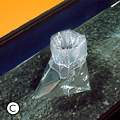
- Float the sealed bag in the aquarium for 15 minutes (Fig. A). Never open the shipping bag at this time. This step allows the water in the shipping bag to adjust slowly to the temperature in the aquarium, while maintaining a high level of dissolved oxygen.
- After floating the sealed shipping bag for 15 minutes, cut open the bag just under the metal clip (Fig. B) and roll
 the top edge of the bag down one inch to create an air pocket within the lip of the bag. This will enable the bag to float on the surface of the water (Fig. C). For heavy pieces of live coral that will submerge the shipping bag, place the bag containing the coral in a plastic bowl or specimen container.
the top edge of the bag down one inch to create an air pocket within the lip of the bag. This will enable the bag to float on the surface of the water (Fig. C). For heavy pieces of live coral that will submerge the shipping bag, place the bag containing the coral in a plastic bowl or specimen container. - Add 1/2 cup of aquarium water to the shipping bag (Fig. D).

- Repeat step 5 every four minutes until the shipping bag is full.
- Lift the shipping bag from the aquarium and discard half the water from the bag (Fig. E).
- Float the shipping bag in the aquarium again and proceed to add 1/2 cup of aquarium water to the shipping bag every four minutes until the bag is full.
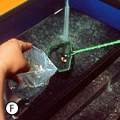
- Net aquatic life from the shipping bag and release into the aquarium (Fig. F).
- Remove the filled shipping bag from the aquarium and discard the water. Never release shipping water directly into
Drip Method

This method is considered more advanced. It is geared toward sensitive inhabitants such as shrimp, sea stars, and wrasses. You will need airline tubing and must be willing to monitor the entire process. Gather a clean, 3 or 5-gallon bucket designated for aquarium use only. If acclimating both fish and invertebrates, use a separate bucket for each. Acclimation kits here.
- Start with Steps 1-3 of the floating method to acclimate water temperature.
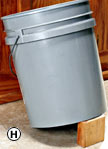
- Carefully empty the contents of the bags (including the water) into the buckets (Fig. G), making sure not to expose sensitive invertebrates to the air. Depending on the amount of water in each bag, this may require tilting the bucket at a 45 degree angle to make sure the animals are fully submerged (Fig. H). You may need a prop or wedge to help hold the bucket in this position until there is enough liquid in the bucket to put it back to a level position.
- Using airline tubing, set up and run a siphon drip line from the main aquarium to each bucket. You’ll need separate airline tubing for each bucket used. Tie several loose knots in the airline tubing, or use a plastic or other non-metal airline control valve, (Fig. I), to regulate flow from the aquarium. It is also a good idea to secure the airline tubing in place with an airline holder.
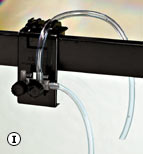
- Begin a siphon by sucking on the end of the airline tubing you’ll be placing into each of the buckets. When water begins flowing through the tubing, adjust the drip (by tightening one of the knots or adjusting the control valve) to a rate of about 2-4 drips per second (Fig. J).
- When the water volume in the bucket doubles, discard half and begin the drip again until the volume doubles once more – about one hour.
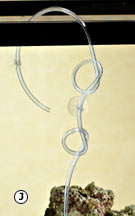
- At this point, the specimens can be transferred to the aquarium. Sponges, clams, and gorgonias should never be directly exposed to air. Gently scoop them out of the drip bucket with the specimen bag, making sure they’re fully covered in water. Submerge the bag underwater in the aquarium and gently remove the specimen from the bag. Next, seal off the bag underwater by twisting the opening, and remove it from the aquarium. Discard both the bag and the enclosed water. A tiny amount of the diluted water will escape into the aquarium; this is O.K. Also, to avoid damage, please remember never to touch the “fleshy” part of live coral when handling.
NOTE: Most invertebrates and marine plants are more sensitive than fish to changes in specific gravity. It is imperative to acclimate invertebrates to a specific gravity of 1.023-1.025 or severe stress or trauma may result. Test specific gravity with a refractometer.
Important Facts
- Be patient – never rush the acclimation procedure. The total acclimation time for your new arrival should take no longer than one hour.
- Always follow the acclimation procedure even if your new arrival appears to be dead. Some fish and invertebrates can appear as though they are dead when they arrive and will usually revive when the above procedure is followed correctly.
- Never place an airstone into the shipping bag when acclimating your new arrival. This will increase the pH of the shipping water too quickly and expose your new arrival to lethal ammonia.
- Keep aquarium lights off for at least four hours after the new arrival is introduced into the aquarium.
- Most invertebrates and marine plants are more sensitive than fish to salinity changes. It is imperative to acclimate invertebrates to a specific gravity of 1.023-1.025 or severe stress or trauma may result.
- Sponges, clams, scallops, and gorgonias should never be directly exposed to air. Follow the acclimation procedure, but instead of netting the specimen out of the shipping bag, submerge the bag underwater in the aquarium and remove the marine life from the bag. Seal off the shipping bag underwater by twisting the opening, and remove it from the aquarium. Discard both the shipping bag and the enclosed water. A tiny amount of the diluted shipping water will escape into the aquarium. Don’t be alarmed; this will have no adverse affect on the tank inhabitants.
- In some instances, your new tank mate will be chased and harassed by one or all of your existing tank mates.Solution 1: A plastic spaghetti strainer (found at your local discount store) can be used to contain a tank bully within the aquarium for several hours until the new arrival adjusts to its surroundings. Just float the perforated plastic basket in the aquarium. Net the tank bully and place in the floating basket for approximately four hours while the new arrival adjusts to your aquarium. Never place the new arrival in this basket; the new specimen must get familiar with your aquarium. By placing the tank bully in a perforated basket, you’ll reduce the stress on your newest tank mate.Solution 2: A perforated plastic lighting grid can be purchased at your local hardware store to cut down the width of your aquarium. This grid may be used to section off a small portion of the aquarium to separate territorial or aggressive fish from the newest tank mate. After the new addition adjusts to the unfamiliar environment, the divider can be removed.
- Some live corals produce excess slime when shipped. After the acclimation procedure is followed, hold the coral by the rock or skeletal base and shake the coral in the shipping bag before placing into the aquarium. To avoid damage, please remember never to touch the “fleshy” part of a live coral. Many species of coral will not open for several days after introduction into their new home. Please allow several days for the coral to adapt to the new conditions in the aquarium.
If a Loss Occurs
We go to great lengths to ensure that the aquarium life we send you arrive in the best condition possible please refer to our Livestock Arrival Conditions
